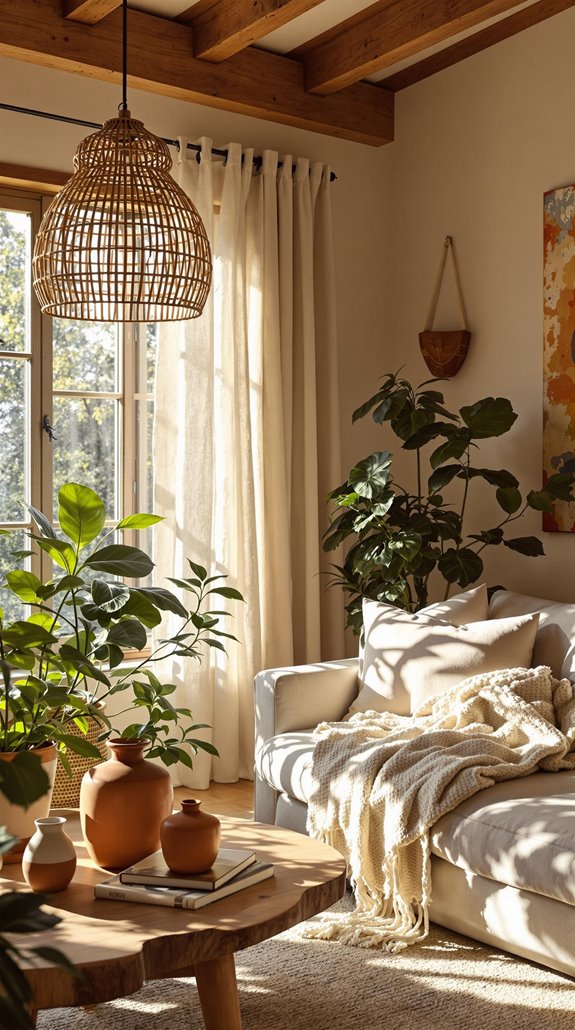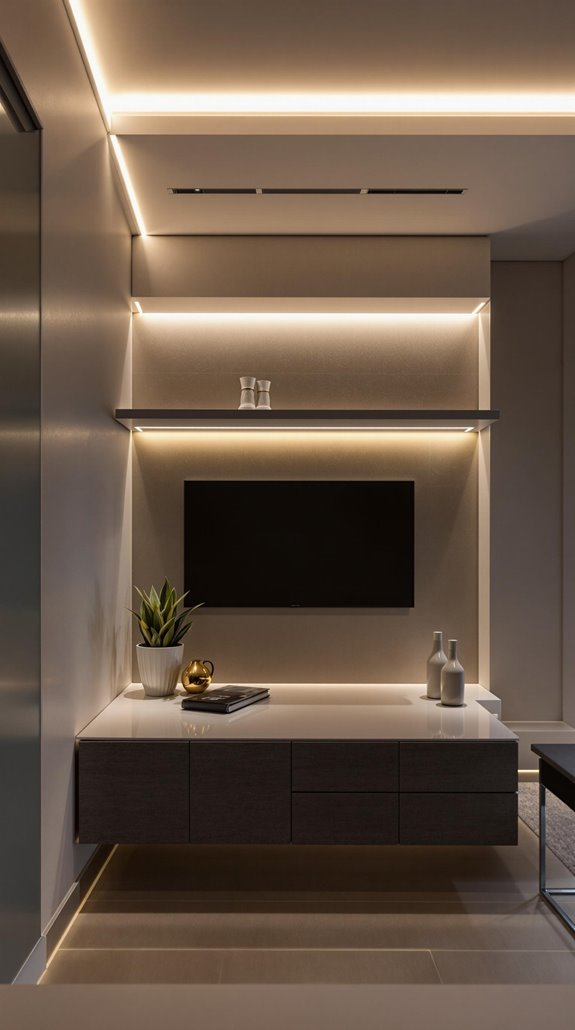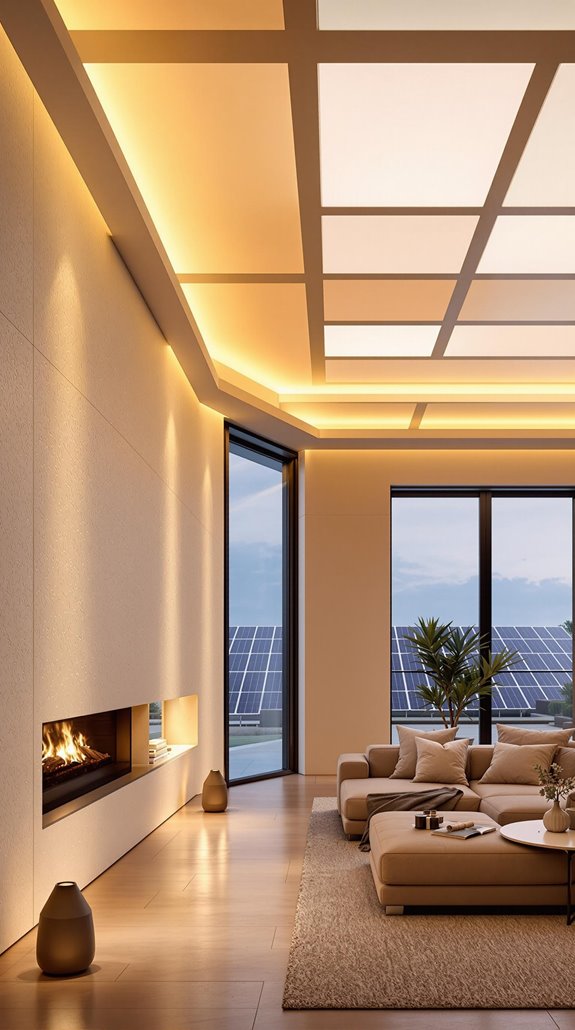I’ve discovered that most homeowners approach lighting as an afterthought, installing basic fixtures without considering how strategic illumination can completely transform their space. Through years of designing lighting systems, I’ve identified five key approaches that’ll elevate your home’s ambiance while reducing energy costs. These methods combine aesthetic appeal with practical functionality, creating environments that adapt to your lifestyle. Let me show you how to implement each technique and avoid the common mistakes that compromise both design and efficiency.
Key Takeaways
- Incorporate bamboo, reclaimed wood, and rattan fixtures for sustainable lighting that adds natural texture and eco-conscious appeal.
- Install oversized sculptural chandeliers and pendant lights as statement pieces to create dramatic visual impact in dining areas.
- Use hidden LED strip lighting in ceilings and coves for sleek, modern illumination that creates floating effects.
- Upgrade vintage fixtures with smart LED bulbs to blend classic charm with modern app-controlled lighting technology.
- Implement smart switches with motion sensors and scheduling to maximize energy efficiency while reducing electricity bills significantly.
Embrace Natural Textures and Sustainable Materials for Warmth

When planning your lighting design, nothing transforms a space quite like incorporating natural textures and sustainable materials that bring authentic warmth to your environment. I recommend selecting bamboo and reclaimed wood fixtures for their durability and eco-conscious appeal. These materials develop rich patinas over time, creating character that synthetic alternatives can’t match.
You’ll find that rattan, seagrass, and jute fixtures add textural diversity while maintaining sustainable credentials. Stone elements introduce organic patterns that make each piece unique. I suggest pairing these materials with natural fiber lampshades using linen or wool to enhance tactile engagement.
Choose fast-growing bamboo for pendant lights or woven chandeliers to minimize environmental impact. These sustainable choices don’t compromise style—they create inviting spaces that connect you with nature while supporting conservation efforts. Additionally, incorporating handcrafted fixtures from local artisans adds distinctive character while supporting your community’s skilled craftspeople.
Make Bold Statements With Oversized and Sculptural Fixtures
While functionality remains paramount in lighting design, oversized and sculptural fixtures serve as powerful design tools that merge illumination with artistic expression. I recommend strategically placing these statement pieces above dining tables or in corners where they’ll command attention without overwhelming your space.
You’ll want to balance visual impact with your room’s proportions—large chandeliers excel in spacious areas but can overpower intimate spaces. For kitchen islands, verify fixtures don’t exceed the island’s width to maintain proper scale. I suggest incorporating innovative materials like tubular steel and ceramic for multidimensional appeal. Additionally, consider layering different light sources to enhance both functionality and ambiance in your space.
Consider abstract forms and color-blocked designs that shift seamlessly between residential and commercial aesthetics. The evolution of chandelier designs reflects various styles from Art Deco to Mid-Century Modern and Scandinavian influences, offering endless possibilities for personal expression. Modular pieces offer customization flexibility, while dimmable options let you adjust ambiance from cozy to vibrant settings, creating the perfect atmosphere for any occasion.
Achieve Clean Lines With Minimalist and Hidden Lighting Solutions

Although dramatic fixtures capture attention, minimalist lighting design achieves sophistication through strategic concealment and architectural integration. I’ll show you how to eliminate visual clutter while maximizing illumination effectiveness. Understanding local market dynamics can also enhance your design choices by guiding you to select features that appeal to potential buyers.
Install LED strip lights under kitchen cabinets and bathroom vanities for sleek task lighting. You’ll create floating effects by placing strips under sofas and shelves, expanding your perceived space dramatically. Motion-sensor and dimmable options add adaptive functionality to your daily routines.
Embed LED strips in ceiling recesses or moldings for diffuse ambient glow. This technique elevates perceived ceiling height while providing even illumination across activity zones. Position recessed lights strategically to layer lighting without protruding fixtures.
Combine cove, recessed, and strip lights for multidimensional illumination. You’ll achieve glare-free ambience through indirect lighting bounced off ceilings, creating professional-grade results that align with minimalist principles. Consider sculptural sconces that blend seamlessly with plastered walls to conceal light sources while maintaining your clean aesthetic.
Revive Vintage Charm With Modern Technology Integration
Modern technology transforms vintage lighting fixtures into smart, efficient systems without sacrificing their timeless appeal. I’ll show you how to seamlessly blend old-world charm with contemporary convenience.
Start by pairing smart LED bulbs with your existing vintage fixtures. Phillips Hue Filament bulbs deliver that authentic amber glow while offering full app control and voice activation. For budget-conscious projects, Wyze bulbs provide excellent RGB options in standard E26 sockets. Properly designed lighting can enhance the atmosphere of your dining space, making it more inviting.
Create hybrid control systems by combining smart bulbs with vintage-style rotary dimmers. This approach gives you both manual operation and automated scheduling. Install analog lamp timers alongside your smart LEDs for scheduled ambiance changes. These thoughtful lighting choices can boost sleep efficiency by approximately 2.4% when they mimic natural dawn and dusk cycles.
Position these upgraded fixtures as focal points above dining tables or in entryways, maintaining neutral palettes to unify vintage pieces with modern décor elements.
Maximize Energy Efficiency With Smart Lighting Technologies

Since lighting accounts for 30% of your household’s electricity consumption, implementing smart lighting technologies can slash your energy bills by 5–22% while reducing your home’s carbon footprint by nearly 13%. I’ll show you how to maximize these savings through strategic automation and integration.
Start by installing smart switches with scheduling capabilities that automatically turn lights off during daylight hours or when rooms are unoccupied. Pair these with motion sensors and geofencing technology to guarantee lights activate only when needed. I recommend integrating LED bulbs, which cut energy use by up to 80% compared to traditional incandescent bulbs. Additionally, consider the benefits of energy-efficient heating systems that can complement your smart lighting setup for overall home efficiency.
Add smart plugs to eliminate phantom loads—they’ll reduce standby power waste by 50%. For extensive efficiency, sync your smart lighting with thermostats and Energy Star-rated appliances to optimize your entire home’s energy consumption patterns. Consider implementing real-time monitoring systems that provide detailed insights into your lighting usage patterns, helping you identify additional opportunities for energy waste reduction.
Conclusion
I’ve outlined five strategic approaches to transform your lighting design—from sustainable materials to smart technology integration. Now it’s time to execute. Start by auditing your current fixtures and identifying priority areas for upgrade. Create a phased implementation plan that balances your budget with maximum impact. Remember, effective lighting design isn’t about following every trend—it’s about selecting solutions that enhance functionality while reflecting your aesthetic vision. Begin with one room and build momentum.
References
- https://www.homesandgardens.com/news/lighting-trends-207692
- https://dominionlighting.com/interior-lighting-trends-for-2025/
- https://www.decorilla.com/online-decorating/lighting-trends-2025/
- https://www.kichler.com/lighting-ideas/blog/home-lighting-and-design-trends-for-2025
- https://mahlanders.com/5-lighting-trends-every-homeowner-should-know-in-2025/
- https://chandelierslife.com/blogs/chandeliers/illuminate-your-space-with-nature-inspired-lighting-a-guide-to-organic-design
- https://allurefurniturewest.com/how-natural-textures-transform-your-interior-design/
- https://www.lightology.com/index.php?module=sets&p=nature-designs
- https://www.kathykuohome.com/Product/ProdGroup/Natural-Lighting
- https://www.anthonymichaelinteriordesign.com/5-biophilic-design-trends-to-turn-your-home-into-a-green-oasis

